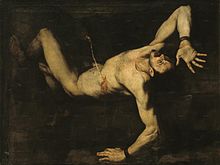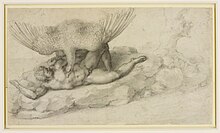Tityos or Tityus (Ancient Greek: Τιτυός) was a giant from Greek mythology.
Family[edit]
Tityos was the son of Elara; his father was Zeus. He had a daughter named Europa who coupled with Poseidonand gave birth to Euphemus, one of the Argonauts.
Mythology[edit]
Zeus hid Elara from his wife, Hera, by placing her deep beneath the earth.[1] Tityos grew so large that he split his mother's womb, and he was carried to term by Gaia, the Earth. Once grown, Tityos attempted to rape Leto at the behest of Hera. He was slain by Leto's protective children Artemis and Apollo.[2] In some accounts, Tityus was instead slain by the thunderbolt of his father Zeus.[3] As punishment, he was stretched out in Tartarus and tortured by two vultures who fed on his liver, which grew back every night.[3] This punishment is comparable to that of the Titan Prometheus.
Jane Ellen Harrison noted that, "To the orthodox worshiper of the Olympians he was the vilest of criminals; as such Homer knew him":
- I saw Tityus too,
- son of the mighty Goddess Earth—sprawling there
- on the ground, spread over nine acres—two vultures
- hunched on either side of him, digging into his liver,
- beaking deep in the blood-sac, and he with his frantic hands
- could never beat them off, for he had once dragged off
- the famous consort of Zeus in all her glory,
- Leto, threading her way toward Pytho's ridge
- over the lovely dancing-rings of Panopeus".[4]
In the early first century, when the geographer Strabo visited Panopeus,[5]he was reminded by the local people that it was the abode of Tityos and recalled the fact that the Phaeacians had carried Rhadamanthys in their boats to visit Tityos, according to Homer.[6] There on Euboea at the time of Strabo they were still showing a "cave called Elarion from Elara who was mother to Tityos, and a hero-shrine of Tityos, and some kind of honours are mentioned which are paid him."[7] It is clear that the local hero-cult had been superseded by the cult of the Olympian gods, an Olympian father provided, and the hero demonized. A comparable giant chthonic pre-Olympian of a Titan-like order is Orion.
The poet Lucretius restyles the figure of Tityos in book III (lines 978-998) of De rerum natura, a demythologized Tityos who is not in the underworld, eternally punished, but here and now, "the prototypical anguished lover", plagued by winged creatures that are not vultures, as E.J. Kenney argues[8] but cupids. Virgil responds to Lucretius with a retrospective simile of Tityos in the Aeneid (6.595ff), which compares his torment of desire with the unrest of Dido, whose flame of love is eating her marrow.[9]
The traveler Pausanias (2nd century A.D.) reports seeing a painting by Polygnotus at Delphi that depicts Tityos among other figures being tormented in Hades for sacrilege: "Tityos too is in the picture; he is no longer being punished, but has been reduced to nothing by continuous torture, an indistinct and mutilated phantom."[10]
https://en.wikipedia.org/wiki/Tityos
In Greek mythology, Elara /ˈɛlərə/, Elare or Alera (Ancient Greek: Ἐλάρα, Ἐλάραη or Ἀλέρα),[1] also called Larissa[2], was a mortal princess, the daughter of King Orchomenus and mother of the giant Tityos by Zeus. In some accounts, she was described as the daughter of Minyas instead.[3][4]
Myth[edit]
Zeus fell in love with Elara and hid her from his wife Hera's jealous rage by placing her deep beneath the Earth. This was where she gave birth to Tityos, a giant who is sometimes said to be the son of Gaia, the Earth goddess, for the reason being an earth-born (γηγενής gigenis "native") and brought up under the earth. It is further added that Elara died in labour because of the enormous size of her baby.[5][6]
The cave through which Tityos was believed to have come to the surface of Earth was located on Euboea and referred to as Elarion.[7]
Eponymy[edit]
One moon of Jupiter is named Elara.[8]
https://en.wikipedia.org/wiki/Elara_(mythology)
In Greek mythology, Minyas (/ˈmɪniəs, ˈmɪnjəs/; Ancient Greek: Μινύας) was the founder of Orchomenus, Boeotia.[1]
Family[edit]
As the ancestor of the Minyans, a number of Boeotian genealogies lead back to him, according to the classicist H.J. Rose. Accounts vary as to his own parentage: one source states that he was thought to be the son of Orchomenus and Hermippe, his real father being Poseidon;[2] in another account he is called a son of Poseidon and Callirhoe[3] or Tritogeneia, daughter of Aeolus[4] or Euryanassa, daughter of Hyperphas[5] or lastly, Chrysogone, daughter of Almus.[6] Yet others variously give Minyas' father as Chryses (son of Poseidon and Chrysogeneia),[7] Eteocles,[8] Aeolus,[1] Ares[citation needed], Aleus[citation needed], Thessalus (son of Poseidon),[9] Sisyphus[10] and Halmus (Almus).
Minyas was married to Euryale, Clytodora, or Phanosyra (daughter of Paeon). Of them, Clytodora bore him a daughter Clymene (also called Periclymene,[11][12] mother of Iphiclus and Alcimede by Phylacus or Cephalus). Clytodora is also given as the mother by Minyas of Orchomenus, Presbon, Athamas,[13] Diochthondas[14] and Eteoclymene.[15] Minyas' other children include Cyparissus, the founder of Anticyra,[16] and three daughters known as the Minyades who were turned into bats.[17] In some accounts, Minyas was also said to be the father of Persephone, mother of Iasus. Iasus was the father of Amphion, who in turn was the father of Chloris and Phylomache (respectively wives of Neleus[18] and Pelias). Also, Elara, the mother of the giant Tityus was also described sometimes as Minyas' daughter.[19]
According to Apollonius Rhodius[20] and Pausanias,[21] he was the first king to have made a treasury, of which the ruins were still extant in Pausanias' times.
https://en.wikipedia.org/wiki/Minyas_(mythology)
In Greek mythology, the name Chloris (/ˈklɔːrɪs/; Greek Χλωρίς Chlōrís, from χλωρός chlōrós, meaning "greenish-yellow", "pale green", "pale", "pallid", or "fresh") appears in a variety of contexts. Some clearly refer to different characters; other stories may refer to the same Chloris, but disagree on details.
- Chloris, a nymph loved by Zephyrus (West Wind).[1]
- Chloris, wife of Neleus, king of Pylos.[2] It is, however, not always clear whether she or the below Chloris is mentioned in this role.
- Chloris, one of the Niobids.[3]
- Chloris, daughter of Orchomenus,[4] married the seer Ampyx (son of Elatus), with whom she had a child Mopsus who also became a renowned seer and would later join the Argonauts.[5][6] The Argonautica Orphica calls her by a different name, Aregonis.[7] In some accounts, she mothered Mopsus by Zeus.[8]
See also[edit]
In Greek mythology, Ampyx (Ancient Greek: Ἄμπυξ) or Ampycus (Ἄμπυκος Ampykos means 'woman's diadem, frontlet') was the name of the following figures:
- Ampyx, also called Ampycus or Ampyce[1] was a seer, the son of Elatus[2] and possibly of Hippeia from Titaresia. He fathered Mopsus with the nymphChloris or Aregonis.[3] His son Mopsus joined the Argonauts after he was slain.[4]
- Ampyx, father of the seer Idmon in some texts.[5] Otherwise, Idmon was called the son of Abas or the god Apollo by Antianeira. Not to be confused with the above-mentioned Ampyx who was the father of another seer, Mopsus.
- Ampyx or Ampycus, an Ethiopian priest of Demeter (Ceres). He appears in Ovid's Metamorphoses[6] and was slain by Phineus during a fight between Phineus and Perseus (see Boast of Cassiopeia), just before Phineus was turned to stone.
- Ampyx or Amycus, son of Opinion, was one of the Lapiths who fought the centaurs at Pirithous's wedding. Appears in Ovid's Metamorphoses.[7]
- Ampyx, son of Pelias, descendant of King Amyclas of Laconia. Through his son Areus, Ampyx became the ancestor of Patreus who founded Patrae.[8]
Other use[edit]
- In hair care, an ampyx is a headband, often made of metal.
Ampyx is an Ordovician-Silurian genus of Asaphid trilobites of the family Raphiophoridae. Species of Ampyx are characterized by three extended spines on the head-shield, one spine derived from each free cheek, and one spine emanating from the glabellum.[1] Species include Ampyx linleyensis (Lanvirn-Caradoc series).[2]
Species of Ampyx grew to an average length of 1.5 inches (3.8 cm).
| Ampyx | |
|---|---|
 | |
| Ampyx cetsarum group | |
| Scientific classification | |
| Kingdom: | Animalia |
| Phylum: | Arthropoda |
| Class: | †Trilobita |
| Order: | †Asaphida |
| Family: | †Raphiophoridae |
| Genus: | †Ampyx Dalman, 1827 |
| Type species | |
| Ampyx nasutus | |
| Species | |
| |
| Synonyms | |
Brachyampyx | |
https://en.wikipedia.org/wiki/Ampyx_(trilobite)



No comments:
Post a Comment